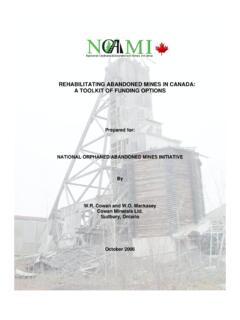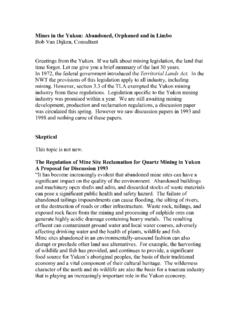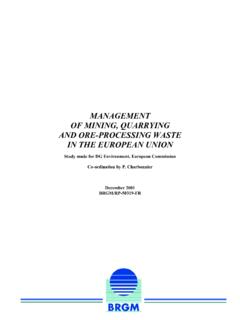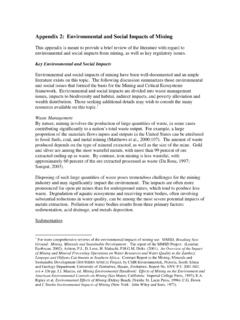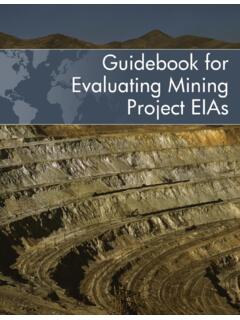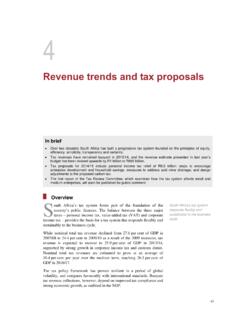Transcription of EXAMINING THE POLICY FRAMEWORK IN CANADAFOR MINE …
1 THE POLICY FRAMEWORK IN CANADA FOR MINE CLOSURE. AND management OF long -TERM liabilities : a guidance document . Prepared for: NATIONAL ORPHANED/ABANDONED mines INITIATIVE. By Cowan, Mackasey and John Robertson Cowan Minerals Ltd. Sudbury, Ontario November, 2010. THE POLICY FRAMEWORK IN CANADA FOR MINE CLOSURE AND. management OF long -TERM liabilities : a guidance document . TABLE OF CONTENTS. DISCLAIMER .. iii EXECUTIVE SUMMARY .. iv R SUM ..x INTRODUCTION ..1. METHODOLOGY ..3. POLICY ELEMENT NOTES ..4. Mine Closure Overview ..4. Risk in Mine Closure Planning ..7. Risk Assessment ..9. Acid Rock Drainage (ARD)..12. Financial Assurance ..14. Cost Estimation ..16. Perpetual Care, long -Term Monitoring and Maintenance ..19. Corporate Failure/Premature Emergency Legislation (Preparedness)..24. Relinquishment ..25. Consultation ..31. Institutional SUMMARY OF QUESTIONNAIRE RESULTS.
2 35. Results of Survey - Canadian Results of Survey- Foreign Respondents ..41. Observations and POLICY Closure Objectives ..47. Closure Financial Assurance ..47. Post-Closure Care ..48. Relinquishment ..48. Institutional Consultation ..48. RECOMMENDATIONS ..49. CONCLUSION ..50. ACKNOWLEDGEMENTS ..51. SELECTED APPENDICES ..54. i LIST OF FIGURES. Figure 1 The Mining Sequence ..5. LIST OF TABLES. Table 1 List of Canadian agencies and response to questionnaire ..37. LIST OF PHOTOS. Photo 1: Typical layout for an underground mine site..8. Photo 2: Abandoned, unprotected mine shaft works..10. Photo 3: Placing a removable shaft Photo 4: View of acid rock drainage Photo 5: Severe acid rock drainage Photo 6: Construction of cap over unsafe underground workings..20. Photo 7: Settling houses over underground coal workings, Nova Photo 8: Control structures for engineered water cover treatment of acidic tailings.
3 28. Photo 9: Run-out of poorly managed mine Photo 10: Open pit mine in northern LIST OF APPENDICES. Appendix A Example Methodology for Evaluating Appendix B Example of Present Value Appendix C POLICY FRAMEWORK for Mine Closure and long -Term liabilities Questionnaire Summary for Canada ..63. Appendix D POLICY FRAMEWORK for Mine Closure and long -Term liabilities Questionnaire Summary for Jurisdictions Outside of The POLICY FRAMEWORK in Canada for Mine Closure and management of long -Term liabilities ii DISCLAIMER. This report was prepared to provide a POLICY FRAMEWORK and guidance document on mine closure and the management of related long -term liabilities . The authors assume no responsibility for actions taken by others on the basis of knowledge acquired from reviewing the material herein. The National Orphaned/Abandoned mines Initiative (NOAMI) Advisory Committee makes no warrantee of any kind with respect to the content and accepts no liability arising from the use of this report.
4 The POLICY FRAMEWORK in Canada for Mine Closure and management of long -Term liabilities iii EXECUTIVE SUMMARY. INTRODUCTION. The National Orphaned and Abandoned mines Initiative (NOAMI) has the role of assessing key abandoned mine issues and recommending to the mines Ministers of Canada actions, collaborative approaches and partnerships toward remediating existing abandoned mines issues and preventing/minimizing the accrual of further abandoned mines liabilities in Canada. When first formed in 2002 NOAMI developed several guiding principles, one of which relates directly to this project: Work toward eliminating future abandonment must continue, including the tightening of regulatory approaches.. This report was prepared in response to the NOAMI initiative to provide a guidance . document FOR MINE CLOSURE AND management OF long -TERM. liabilities : EXAMINING THE POLICY FRAMEWORK IN CANADA.
5 The guidance document is to provide a plain language, readable text for use as a reference document by a diverse group of stakeholders including Industry, Aboriginal Canadians, Government and NGO members. For those mining jurisdictions in Canada which may need POLICY development in these areas, this document will provide a starting point. It examines the main components related to mine closure and post-closure site management which can include long -term maintenance and monitoring liabilities . It considers long - term care, monitoring and maintenance of mines which may cease to operate and the options whereby mining jurisdictions may accept mining lands back to the Crown. METHODOLOGY. To execute this project a two-pronged approach was taken. Firstly, to obtain current information on how the issues under discussion are currently managed, a questionnaire was developed and sent to 17 agencies within Canada.
6 A slightly revised version of the questionnaire was sent to some 20 foreign jurisdictions within which mining is a significant economic endeavor. Information garnered from the questionnaires was compiled and collated. Key information points or findings from the questionnaire are provided in the observations and trends below. The second step was the preparation of brief notes on potential POLICY elements from which guidance concepts for a POLICY FRAMEWORK could be developed. These notes provide background information for readers on issues of mine closure and abandoned mines . OBSERVATIONS AND TRENDS FROM QUESTIONNAIRE. Results gathered from the NOAMI questionnaire provide the following snapshot of existing legislation/regulations/policies/practic es in jurisdictions for mine closure. Much progress has been made in this field over the last 40 years, and continues to be made.
7 Statutory authority for the requirement of closure plans by jurisdictions is now the norm. Some jurisdictions use the term reclamation plan instead of closure plan or as a precursor to the closure plan . One window permitting is the exception rather than the rule. The POLICY FRAMEWORK in Canada for Mine Closure and management of long -Term liabilities iv For the most part there were few major gaps identified within/between permits by jurisdictions. Very few jurisdictions appear to include exploration as a closure plan trigger. Most responders appear to include every element of an active production site in closure plans. Little mention is made of risk imposed by third party interference with rehabilitation works. The Province of Saskatchewan has established a process under its Reclaimed Industrial Sites Act and related regulations and policies to provide an approach for long -term care and monitoring following closure.
8 It appears to be the only Canadian jurisdiction to have done so. While several agencies report they will not accept properties with ongoing water treatment/contamination concerns, there is little discussion on how these sites will be maintained (funding and management ) once the proponents ultimately disappear. This is a particularly important concern for the long -term care and monitoring of closed uranium mines . There is little discussion of catastrophic events or contingency response planning for worst-case scenarios. While self assurance is accepted by some jurisdictions, a number of respondents consider it to be an inadequate form of financial assurance. A number of agencies use spreadsheets, computer models and other tools to calculate financial assurance. This can provide consistency not only for the regulatory agency but also for the proponent.
9 Not all agencies use Net Present Value as a tool to calculate long -term care and monitoring costs following closure. One respondent sees problems with this method. No widely accepted process appears to be identified for calculating long - term monitoring, care and maintenance costs. The main focus for Emergency Response Plans appears to be for operating mines , not for closed out sites (with limited access, infrastructure and technical/human resources). There is no consistent approach for storing and safeguarding critical maps and documents which also provides for rapid retrieval of information in the event of emergencies. There is a now a greater focus on Aboriginal consultation. Several jurisdictions have created special consultation units. A number of responders have provision for return of mining lands to the Crown but the process appears subjective in some instances.
10 Several agencies have release documents but do not/cannot grant environmental liability release. A number will not accept sites with long -term treatment facilities. POLICY FRAMEWORK . A strong POLICY FRAMEWORK is necessary to develop a robust, effective and fair mine development, mine closure and long -term care regulatory system and to minimize the further accrual of abandoned mine features. The following sections provide a brief POLICY FRAMEWORK , which is intended to provide guidance to jurisdictions with evolving mine The POLICY FRAMEWORK in Canada for Mine Closure and management of long -Term liabilities v closure regulatory programs. It is not intended to be an exhaustive listing of issues and what ifs ; further guidance is provided in other sections of this report. Jurisdictions must develop their own POLICY direction within their sustainable mining niche in a global market including their level of risk tolerance or aversion.



